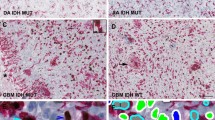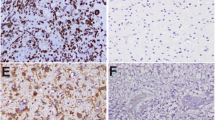Abstract
p27/kip1 regulates the G1-S transition of the cell cycle by inhibiting cyclinD-CDK4, cyclinE-CDK2 and cyclinA-CDK2 complexes. Regulation of p27 levels occurs mainly post-translationally by ubiquitin-mediated proteasomal proteolysis. Although genetic changes of p27/kip1 are extremely rare, in many human carcinomas p27 levels are reduced, correlate with histological malignancy, and are associated with poor prognosis. In astrocytic gliomas, p27 decreases with anaplasia and is almost absent in glioblastomas. p27/kip1 was immunohistochemically studied in 37 oligodendrogliomas, categorized according to WHO classification. In this series, the immunohistochemical reaction for p27 was confined to nuclei. p27 score showed a tendency to decrease with malignancy. When the p27 score was considered as high versus low expression (cut-off of p27 labeling index, LI, at 25%), it represented an independent prognostic factor in univariate (P = 0.02) and in multivariate analysis (P = 0.04). The risk ratio suggested that the p27 low expression group had a threefold increased possibility to show a reduced survival. Moreover, p27 levels did not correlate with MIB-1 LI, suggesting that p27 is not merely associated with the control of proliferation.
Similar content being viewed by others
Author information
Authors and Affiliations
Additional information
Received: 13 November 1998 / Accepted: 16 March 1999
Rights and permissions
About this article
Cite this article
Cavalla, P., Piva, R., Bortolotto, S. et al. p27/kip1 expression in oligodendrogliomas and its possible prognostic role. Acta Neuropathol 98, 629–634 (1999). https://doi.org/10.1007/s004010051128
Issue Date:
DOI: https://doi.org/10.1007/s004010051128




